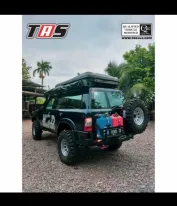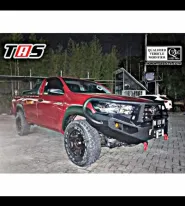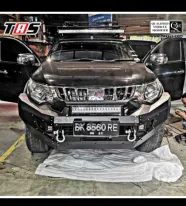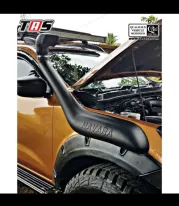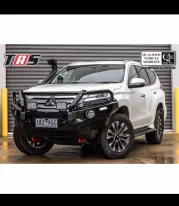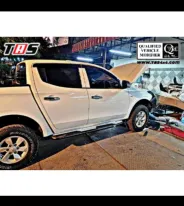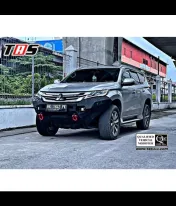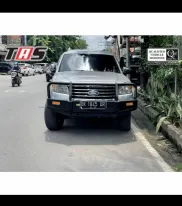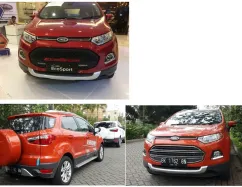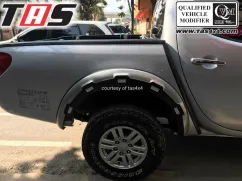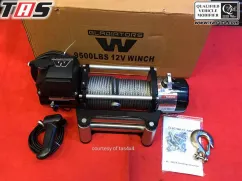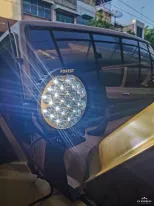OUR PRODUCT
Recent Article
Untuk lift kit Toyota Fortuner / Vigo-revo / FJ cruiser / Prado 150-120 / Landcrusier 200 series
Untuk lift kit Toyota Fortuner / Vigo-revo / FJ cruiser / Prado 150-120 / Landcrusier 200 series
ada kendala di body mounting yang terlalu dekat ke posisi ban
Design Chasis Toyota untuk memenuhi std keamanan Ancap 5 , body mounting tengah sekaligus penahan ban , agar saat tabrakan ban tertahan chasis. jika mobil telah lift 2 inch , posisi horizontal ban sudah lebih tinggi dari chasis, dan jika " penahan ban " di potong, tak akan mengurangi fungsi penahan ban tersebut
Untuk Offroad betulan Chasis harus di potong atau di Trim .
ada kendala di body mounting yang terlalu dekat ke posisi ban
Design Chasis Toyota untuk memenuhi std keamanan Ancap 5 , body mounting tengah sekaligus penahan ban , agar saat tabrakan ban tertahan chasis. jika mobil telah lift 2 inch , posisi horizontal ban sudah lebih tinggi dari chasis, dan jika " penahan ban " di potong, tak akan mengurangi fungsi penahan ban tersebut
Untuk Offroad betulan Chasis harus di potong atau di Trim .
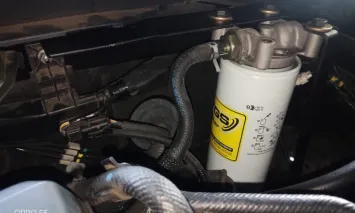 Sayangi mobil anda!
Sayangi mobil anda! Sayangi mobil anda!
Jika Anda memiliki SUV diesel, van, atau 4WD, kami harap Anda baca artikel ini ,karena apa yang akan kami katakan akan sangat mengejutkan. Tidaklah berlebihan untuk mengatakan bahwa ada risiko bahwa setiap tangki bahan bakar yang Anda masukkan ke kendaraan Anda membawa risiko kontaminasi air yang dapat menghancurkan seluruh sistem bahan bakar dan bahkan mesin dalam kilometer! Walaupun mengisi dari pertamnina bermerek/ minyak berkualitas Dan tidak terlalu sering bepergian - setiap kendaraan berisiko. Itulah mengapa sangat penting bahwa Anda memasang saringan tambahan solar tgs ke mobil anda
Jadi dari mana datangnya potensi kerusakan, dan mengapa Anda harus memasang tambahan saringan solar tgs kendaraan Anda? Masalahnya adalah dua kali lipat. Pertama, ada peningkatan jumlah kegagalan sistem bahan bakar yang disebabkan oleh air dalam diesel berkat tangki pertamina di seluruh negeri yang menua dan berkarat.
Jadi mengapa Anda tidak bisa mengandalkan filter bahan bakar pabrik Anda, terutama jika memiliki lampu peringatan untuk memberi tahu Anda ketika itu diisi dengan air? Masalahnya adalah saat lampu peringatan menyala, seringkali sudah terlambat. Pada tahap itu, ada peluang bagus bahwa air telah berhasil melewati filter bahan bakar pabrik Anda. Pada saat Anda berhenti di sisi jalan untuk menyelidiki, mungkin sudah terlambat dan kerusakan mungkin sudah dilakukan.
Untuk mobil diesel modren, injeksi commonrail adalah hal umum untuk mendapatkan HP dan torsi yg besar, cuma masalah terbesar dari mesin commonrail adalah kualitas dan kebersihan bahan bakar solar.
untuk mengatsi kualitas solar yg buruk , sangat disarankan memasang extra filter. pilihan extra filter juga ngak boleh sembarangan, harus sesuai sengan kapasitas mesin( Flow & Micron ). juga harus diperhatikan kualitas desain breket dan selang, yang mana breket dan selang sebaiknya tinggal pasang " plug and play "
- Satu-satunya Filter dengan 5 lapisan stratapore yg mampu menyaring emulsi ( air yg telah bercampur dengan solar )
- Satu-satunya Filter dengan 5 lapisan stratapore yg mampu menyaring emulsi ( air yg telah bercampur dengan solar )
- Extra Fuel Filter TGS memang didesain khusus untuk aplikasi sebagai Pre filter mesin kapasitas 8000cc – 500 hp
- Dgn Flow rate antara 90 GPH , tidak akan menyebabkan resistansi dari pemasangan extra fuel Filter ( untuk mesin 2500cc 170 HP Cuma membutuhkan 32 GPH )
- Stratapore memiliki daya serap kotoran yg besar & efisien ( 30 kali lebih besar dibanding saringan OEM biasa /cellulosa - capasitas hingga 72 gram ), sehingga bisa bertahan hingga pemakaian 30.000km
- Aplikasi pre filter tidak mencopot selang OEM & ukuran diameter selang tetap seperti OEM ( tidak terjadi hambatan di selang )
- Untuk aplikasi di mesin Tanpa Common rail, mengunakan FS1000 10 micron. pemasangan filter tambahan setelah filter utama OEM
- Untuk Aplikasi di mesin Common rail, mengunakan filter 10 micron absolut , pemasangan filter tambahan sebelum filter utama OEM
Jika Anda memiliki SUV diesel, van, atau 4WD, kami harap Anda baca artikel ini ,karena apa yang akan kami katakan akan sangat mengejutkan. Tidaklah berlebihan untuk mengatakan bahwa ada risiko bahwa setiap tangki bahan bakar yang Anda masukkan ke kendaraan Anda membawa risiko kontaminasi air yang dapat menghancurkan seluruh sistem bahan bakar dan bahkan mesin dalam kilometer! Walaupun mengisi dari pertamnina bermerek/ minyak berkualitas Dan tidak terlalu sering bepergian - setiap kendaraan berisiko. Itulah mengapa sangat penting bahwa Anda memasang saringan tambahan solar tgs ke mobil anda
Jadi dari mana datangnya potensi kerusakan, dan mengapa Anda harus memasang tambahan saringan solar tgs kendaraan Anda? Masalahnya adalah dua kali lipat. Pertama, ada peningkatan jumlah kegagalan sistem bahan bakar yang disebabkan oleh air dalam diesel berkat tangki pertamina di seluruh negeri yang menua dan berkarat.
Jadi mengapa Anda tidak bisa mengandalkan filter bahan bakar pabrik Anda, terutama jika memiliki lampu peringatan untuk memberi tahu Anda ketika itu diisi dengan air? Masalahnya adalah saat lampu peringatan menyala, seringkali sudah terlambat. Pada tahap itu, ada peluang bagus bahwa air telah berhasil melewati filter bahan bakar pabrik Anda. Pada saat Anda berhenti di sisi jalan untuk menyelidiki, mungkin sudah terlambat dan kerusakan mungkin sudah dilakukan.
Untuk mobil diesel modren, injeksi commonrail adalah hal umum untuk mendapatkan HP dan torsi yg besar, cuma masalah terbesar dari mesin commonrail adalah kualitas dan kebersihan bahan bakar solar.
untuk mengatsi kualitas solar yg buruk , sangat disarankan memasang extra filter. pilihan extra filter juga ngak boleh sembarangan, harus sesuai sengan kapasitas mesin( Flow & Micron ). juga harus diperhatikan kualitas desain breket dan selang, yang mana breket dan selang sebaiknya tinggal pasang " plug and play "
- Satu-satunya Filter dengan 5 lapisan stratapore yg mampu menyaring emulsi ( air yg telah bercampur dengan solar )
- Satu-satunya Filter dengan 5 lapisan stratapore yg mampu menyaring emulsi ( air yg telah bercampur dengan solar )
- Extra Fuel Filter TGS memang didesain khusus untuk aplikasi sebagai Pre filter mesin kapasitas 8000cc – 500 hp
- Dgn Flow rate antara 90 GPH , tidak akan menyebabkan resistansi dari pemasangan extra fuel Filter ( untuk mesin 2500cc 170 HP Cuma membutuhkan 32 GPH )
- Stratapore memiliki daya serap kotoran yg besar & efisien ( 30 kali lebih besar dibanding saringan OEM biasa /cellulosa - capasitas hingga 72 gram ), sehingga bisa bertahan hingga pemakaian 30.000km
- Aplikasi pre filter tidak mencopot selang OEM & ukuran diameter selang tetap seperti OEM ( tidak terjadi hambatan di selang )
- Untuk aplikasi di mesin Tanpa Common rail, mengunakan FS1000 10 micron. pemasangan filter tambahan setelah filter utama OEM
- Untuk Aplikasi di mesin Common rail, mengunakan filter 10 micron absolut , pemasangan filter tambahan sebelum filter utama OEM
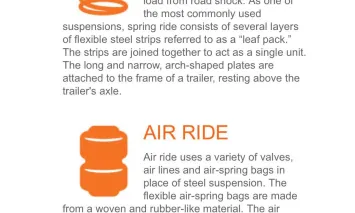 A DEEPER LOOK AT SPRING VS. AIR
A DEEPER LOOK AT SPRING VS. AIRA DEEPER LOOK AT SPRING VS. AIR
Suspension systems contribute to a tractor-trailer’s road handling and ride quality (the vertical acceleration to which a tractor-trailer is exposed). Keeping the tires in contact with the road as much as possible, suspension systems help minimize the amount of jarring (bumps, vibrations) for improved load-carrying ability, protecting the trailer and the freight inside from being damaged.
Suspension systems contribute to a tractor-trailer’s road handling and ride quality (the vertical acceleration to which a tractor-trailer is exposed). Keeping the tires in contact with the road as much as possible, suspension systems help minimize the amount of jarring (bumps, vibrations) for improved load-carrying ability, protecting the trailer and the freight inside from being damaged.
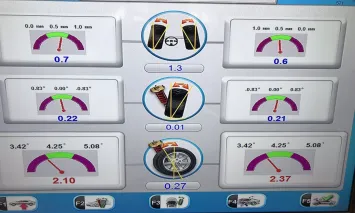 Wheels alignment report
Wheels alignment reportPlease see below email from our Local Sales Manager reporting the feedback to Kristian after one of our dealers install UCA001FA on his Hilux Revo ( he’s putting oversized tire too )
I’m not sure how important is wheel alignment in your market but it’s very important to do proper wheel alignment after raising the vehicle with suspension upgrade ( changing spring )
I’m not sure how important is wheel alignment in your market but it’s very important to do proper wheel alignment after raising the vehicle with suspension upgrade ( changing spring )
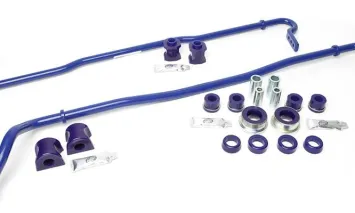 KETIDAK PAHAMAN MODIFIKASI SWAYBAR PADA UMUMNYA
KETIDAK PAHAMAN MODIFIKASI SWAYBAR PADA UMUMNYASWAY BAR OEM
Untuk offroad malah akan mengurangi traksi LC200 mengguakan KDDS untuk non aktifkan swaybar saat offroad JK Rubicon memiliki fasilitas non aktif front swaybar via switch saat offroad .
Jika diganti ukuran lebih gemuk dengan asumsi berat mobil tetap / tak bertambah sesuai desain pabrik
Penggunaan front swaybar lebih gemuk , handling menjadi under steer
Pengganti rear swaybar lebih gemuk . handling menjadi over driver
Sway bars
This component mst be the least well understood component of suspension . or maybe just the easiest for people who don’t know suspension tunning to want to mess with . more often than not people looking for aftermarket sway bars just assume it’s an upgrade but generally have on idea why or how . often people seem to assume that a stiffer bar at one end of the car will increase traction at that end of the car . it would be a natura; conclusion . after all everyone believes that bigger sway bars increase traction but they really don’t . A stiffer sway bar at one end of the car will reduce traction at that end it is increasing the effective spring rate winch is transferring traction to the other end of the car . add a stiffer front sway bar and the car will become more understeery in the front and less oversteery in the back . if that’s what you want then the sway bar can be a good tuning tool . if you add stiffer sway bars front and rear it will reduce the amount of roll while maintaining similar hadling characteristics . if you cannot change spring rates up the a little bit . peronally if possible I belive one shuld try to get the spring rates asclose as possible then just fine tune with sway bars .
It is also good to remember that stiffer sway bars reducse roll but not pitch . so a car with stiffer springs ad softer bars will reduce both pitch and roll whereas slapping big sway bars on stock suspension will reduce roll but still have a lot of pitch . contraty to comments in other articles pitch is not a big thing to shoot for . naturally there is a happy balance and too much or too little of anything will become bad there is a common saying with macpherson suspension tuning and there is somr truth to it . the saying goes something like the best way tu get macpherson suspension to handle well is to keep if from moving . of course this is not litteraly true but it contains seed of truth . mapherson suspension does ot have the best geometry and gig changes in suspension travel tend to take toe , caster . camber , etc curves further from ideal . so while you do want the suspension traveling enough to absorb imperfections on the road and keep the tires as close as possible to optimal grip you don’t want a ton of pitch or roll as you come into a corner because the more your suspension travels the less ideal your geometry will likely become . if someone does find more pitch improves their turn in then it is likely that their suspension geometry was actually improved and that changing thestatic geometry with reduce pitch would probably produce even better results .
Another big misconption with sway bars is that they will try to lift the inside tire . often these people will believe that therefore a setup with stiffer springs and no sway bars would put more pressure on that inside tire , it is easy to think of things in that way but that’s just now how it works .
Think of it like this . weight distribution is dictated by center of gravity and G forces . so whether you were doing around a corner with zero suspension or with soft suspension and huge sway bar or stiff suspension and no sway bar the weight of the car pushing down on each tire is dictated by COG and cornering force . The sway bar is not pulling the inside tire up . it is reducing roll and keeping the inside of the car lower . it is true that if the car rolls . enough a sway bar will make it more likely for a car to actually lift a tire off the ground but with no sway bar there would still be zero weight on the tire . it might be resting on the ground but it’s ability to trun or accelerate would realy be no better .
The stiff . front spring no sway bar setup became very popular in the AW11 scne after a few people found success with it in particular classes of autox . I can’t guarantee I could build a more competitive setup tn that class of racing but that doesn’t change the fact that the threads and discussion of this setup are built on a lot of bad theory and correlation . so if you are looking for a competitive setup for that class of racing don completely dismiss if but if you are looking for proper technical discussion or accurate theory understand that just because someone wins races withy their setup does not mean they understand why or that it couldn’t be improved upon if they did . a lot of rasons given for getting rid of the sway bar in these threads are not true or technically correct and things I addressed above like someone assuming that a sway bar was significantly less ideal because it would reduce weight on the inside tire which is absolutely not true .
This C4AG article also recommends running different pads in the front to change braking bias . this is not really suspension related but this is a huge pet peeve of mine so I’ll add it in .
Untuk offroad malah akan mengurangi traksi LC200 mengguakan KDDS untuk non aktifkan swaybar saat offroad JK Rubicon memiliki fasilitas non aktif front swaybar via switch saat offroad .
Jika diganti ukuran lebih gemuk dengan asumsi berat mobil tetap / tak bertambah sesuai desain pabrik
Penggunaan front swaybar lebih gemuk , handling menjadi under steer
Pengganti rear swaybar lebih gemuk . handling menjadi over driver
Sway bars
This component mst be the least well understood component of suspension . or maybe just the easiest for people who don’t know suspension tunning to want to mess with . more often than not people looking for aftermarket sway bars just assume it’s an upgrade but generally have on idea why or how . often people seem to assume that a stiffer bar at one end of the car will increase traction at that end of the car . it would be a natura; conclusion . after all everyone believes that bigger sway bars increase traction but they really don’t . A stiffer sway bar at one end of the car will reduce traction at that end it is increasing the effective spring rate winch is transferring traction to the other end of the car . add a stiffer front sway bar and the car will become more understeery in the front and less oversteery in the back . if that’s what you want then the sway bar can be a good tuning tool . if you add stiffer sway bars front and rear it will reduce the amount of roll while maintaining similar hadling characteristics . if you cannot change spring rates up the a little bit . peronally if possible I belive one shuld try to get the spring rates asclose as possible then just fine tune with sway bars .
It is also good to remember that stiffer sway bars reducse roll but not pitch . so a car with stiffer springs ad softer bars will reduce both pitch and roll whereas slapping big sway bars on stock suspension will reduce roll but still have a lot of pitch . contraty to comments in other articles pitch is not a big thing to shoot for . naturally there is a happy balance and too much or too little of anything will become bad there is a common saying with macpherson suspension tuning and there is somr truth to it . the saying goes something like the best way tu get macpherson suspension to handle well is to keep if from moving . of course this is not litteraly true but it contains seed of truth . mapherson suspension does ot have the best geometry and gig changes in suspension travel tend to take toe , caster . camber , etc curves further from ideal . so while you do want the suspension traveling enough to absorb imperfections on the road and keep the tires as close as possible to optimal grip you don’t want a ton of pitch or roll as you come into a corner because the more your suspension travels the less ideal your geometry will likely become . if someone does find more pitch improves their turn in then it is likely that their suspension geometry was actually improved and that changing thestatic geometry with reduce pitch would probably produce even better results .
Another big misconption with sway bars is that they will try to lift the inside tire . often these people will believe that therefore a setup with stiffer springs and no sway bars would put more pressure on that inside tire , it is easy to think of things in that way but that’s just now how it works .
Think of it like this . weight distribution is dictated by center of gravity and G forces . so whether you were doing around a corner with zero suspension or with soft suspension and huge sway bar or stiff suspension and no sway bar the weight of the car pushing down on each tire is dictated by COG and cornering force . The sway bar is not pulling the inside tire up . it is reducing roll and keeping the inside of the car lower . it is true that if the car rolls . enough a sway bar will make it more likely for a car to actually lift a tire off the ground but with no sway bar there would still be zero weight on the tire . it might be resting on the ground but it’s ability to trun or accelerate would realy be no better .
The stiff . front spring no sway bar setup became very popular in the AW11 scne after a few people found success with it in particular classes of autox . I can’t guarantee I could build a more competitive setup tn that class of racing but that doesn’t change the fact that the threads and discussion of this setup are built on a lot of bad theory and correlation . so if you are looking for a competitive setup for that class of racing don completely dismiss if but if you are looking for proper technical discussion or accurate theory understand that just because someone wins races withy their setup does not mean they understand why or that it couldn’t be improved upon if they did . a lot of rasons given for getting rid of the sway bar in these threads are not true or technically correct and things I addressed above like someone assuming that a sway bar was significantly less ideal because it would reduce weight on the inside tire which is absolutely not true .
This C4AG article also recommends running different pads in the front to change braking bias . this is not really suspension related but this is a huge pet peeve of mine so I’ll add it in .
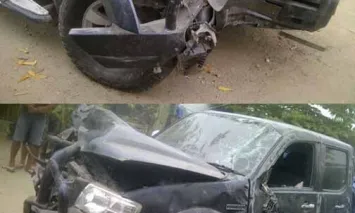 Analisa palang pipa dgn winch mount berdasark aspek keselamatan NHTSA:
Analisa palang pipa dgn winch mount berdasark aspek keselamatan NHTSA:Analisa palang pipa dgn winch mount berdasark aspek keselamatan NHTSA:
- Palang pipa > tanpa crumple zone ( yg berfungsi untuk menyerap energi tabrakan )juga meberikan signal yg salah pada G sensor Airbag – mengaktifkan airbag terlalu dini, sehigga tidak compatible dgn Airbag system
- Instalasi winch diluar > adalah ilegal > Roller winch diluar + sudut yg tajam sangat berbahaya saat tabrakan. Potensi cedera & korban tersangkut di palang pipa sangat besar (melanggar peraturan sharp object – pedestrian safety rules )
- Preasure point saat tabrakan pada palang pipa bisa 90 x lipat dari Winch bar Forest ( contoh: misalnya saat tabrakan area yg contact selebar 70 cm > pada palang pipa contact point > 20 cm x2mm = 14cm/segi. Pada winchbar Forest > 18cm x 70 cm = 1260cm/segi. Dgn asumsi mobil LV ( 1900 kg ) melaju dgn kecepatan 50 km/jam saat tabrakan energi kinetik adalah 70.000 joule . contact point pada palang pipa adalah sebesar 5000 joule/ sq cm – contact point pada winch bar Forest Cuma 55,5 joule/sq cm ) contoh clasik adalah Tank Abraham seberat 70 ton memiliki preasure point ketanah setara luas kedua kaki perempuan seberat 50kg.Preasure point > memusatkan energi pada titik kecil , sehingga efek merusak sangat besar.
- Menggangu mobilitas > palang pipa menjadikan mobil lebih panjang 35 cm ( diukur dari titik roller winch ) – pada Winch bar Forest Cuma lebih panjang 12cm
- Mengurangi Approach angel hingga 5 derajat ( sangat menggangu saat tanjakan ) – pada Winch bar Forest > Justru memperbaiki approach angle hingga 3 derajat
Perbandingan dgn Palang Winch bar Forest:
- Memiliki crumple zone & telah lulus sertifikasi keselamatan ADR69/00 - Airbag compatible
- Desain memenuhi sharp object rule – ada 2 karet peredam benturan didepan – ketiadaan sudut keras/runcing di palang – winch roller dipasang tersembunyi
- Palang yg ramping membantu mobilitas & memperbaiki apporch angle
- Sebagai tempat untuk winch – 3 dudukan antena – 2 hilift jack point – tempat lampu
- Palang dilengkapi 3 skid plate & lampu indikator led
Hasil test Cuma untuk kalangan sendiri & pihak yg terkait – tidak di perkenankan untuk disebarluaskan tanpa confirmasi dari pihak PT Sukses Selaras SentosaThis information is subject to change. Confidential information, which should not be shared with a third partywithout a written consent from PT Sukses Selaras Sentosa Representative.
- Palang pipa > tanpa crumple zone ( yg berfungsi untuk menyerap energi tabrakan )juga meberikan signal yg salah pada G sensor Airbag – mengaktifkan airbag terlalu dini, sehigga tidak compatible dgn Airbag system
- Instalasi winch diluar > adalah ilegal > Roller winch diluar + sudut yg tajam sangat berbahaya saat tabrakan. Potensi cedera & korban tersangkut di palang pipa sangat besar (melanggar peraturan sharp object – pedestrian safety rules )
- Preasure point saat tabrakan pada palang pipa bisa 90 x lipat dari Winch bar Forest ( contoh: misalnya saat tabrakan area yg contact selebar 70 cm > pada palang pipa contact point > 20 cm x2mm = 14cm/segi. Pada winchbar Forest > 18cm x 70 cm = 1260cm/segi. Dgn asumsi mobil LV ( 1900 kg ) melaju dgn kecepatan 50 km/jam saat tabrakan energi kinetik adalah 70.000 joule . contact point pada palang pipa adalah sebesar 5000 joule/ sq cm – contact point pada winch bar Forest Cuma 55,5 joule/sq cm ) contoh clasik adalah Tank Abraham seberat 70 ton memiliki preasure point ketanah setara luas kedua kaki perempuan seberat 50kg.Preasure point > memusatkan energi pada titik kecil , sehingga efek merusak sangat besar.
- Menggangu mobilitas > palang pipa menjadikan mobil lebih panjang 35 cm ( diukur dari titik roller winch ) – pada Winch bar Forest Cuma lebih panjang 12cm
- Mengurangi Approach angel hingga 5 derajat ( sangat menggangu saat tanjakan ) – pada Winch bar Forest > Justru memperbaiki approach angle hingga 3 derajat
Perbandingan dgn Palang Winch bar Forest:
- Memiliki crumple zone & telah lulus sertifikasi keselamatan ADR69/00 - Airbag compatible
- Desain memenuhi sharp object rule – ada 2 karet peredam benturan didepan – ketiadaan sudut keras/runcing di palang – winch roller dipasang tersembunyi
- Palang yg ramping membantu mobilitas & memperbaiki apporch angle
- Sebagai tempat untuk winch – 3 dudukan antena – 2 hilift jack point – tempat lampu
- Palang dilengkapi 3 skid plate & lampu indikator led
Hasil test Cuma untuk kalangan sendiri & pihak yg terkait – tidak di perkenankan untuk disebarluaskan tanpa confirmasi dari pihak PT Sukses Selaras SentosaThis information is subject to change. Confidential information, which should not be shared with a third partywithout a written consent from PT Sukses Selaras Sentosa Representative.
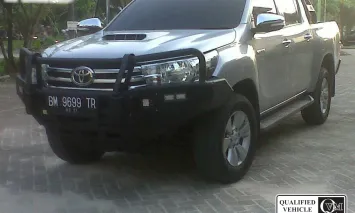 Analisa kerusakan ECM lampu pada Ford T6/PX Batang toru
Analisa kerusakan ECM lampu pada Ford T6/PX Batang toruAnalisa kerusakan ECM lampu pada Ford T6/PX Batang toru
Ford T6 – PX mengunakan system wiring yg ter integerasi sehingga penambahan beban arus pada kabel OEM adalah sangat berbahaya.
Pengetesan :
- Kabel lampu belakang ( tail ) diberi tambahan beban 2 lampu 5 watt ( total 10 watt ), ECM tidak dapat mendeteksi adanya tambahan beban pada system lampu
- Jika beban lampu di beri tambahan 3 watt ( jadi totalnya 10 watt + 3 watt ) , ECM akan memutuskan arus & system akan reset ( hidup kembali ) , jika kunci kontak dimatikan & di hidupkan kembali
Kesimpulan :
ECM akan mematikan arus jika ada pembeban arus di atas 1 amp atau pun short ( arus pendek ), ECM tidak bisa mematikan arus jika ada pembeban < 1 A . hal ini menjadi masalah kerusakan ECM saat pembebanan 2 lampu senja biasa ( bukan led ) kapasitas 5 watt , bisa membuat kabel panas & merusak ECM
Solusi :
Semua lampu yg di jumper ke wiring OEM harus type led & < 0,2 amp
Hasil test Cuma untuk kalangan sendiri & pihak yg terkait – tidak di perkenankan untuk disebarluaskan tanpa confirmasi dari pihak PT Sukses Selaras Sentosa
This information is subject to change. Confidential information, which should not be shared with a third party
without a written consent from PT Sukses Selaras Sentosa Representative.
Ford T6 – PX mengunakan system wiring yg ter integerasi sehingga penambahan beban arus pada kabel OEM adalah sangat berbahaya.
Pengetesan :
- Kabel lampu belakang ( tail ) diberi tambahan beban 2 lampu 5 watt ( total 10 watt ), ECM tidak dapat mendeteksi adanya tambahan beban pada system lampu
- Jika beban lampu di beri tambahan 3 watt ( jadi totalnya 10 watt + 3 watt ) , ECM akan memutuskan arus & system akan reset ( hidup kembali ) , jika kunci kontak dimatikan & di hidupkan kembali
Kesimpulan :
ECM akan mematikan arus jika ada pembeban arus di atas 1 amp atau pun short ( arus pendek ), ECM tidak bisa mematikan arus jika ada pembeban < 1 A . hal ini menjadi masalah kerusakan ECM saat pembebanan 2 lampu senja biasa ( bukan led ) kapasitas 5 watt , bisa membuat kabel panas & merusak ECM
Solusi :
Semua lampu yg di jumper ke wiring OEM harus type led & < 0,2 amp
Hasil test Cuma untuk kalangan sendiri & pihak yg terkait – tidak di perkenankan untuk disebarluaskan tanpa confirmasi dari pihak PT Sukses Selaras Sentosa
This information is subject to change. Confidential information, which should not be shared with a third party
without a written consent from PT Sukses Selaras Sentosa Representative.
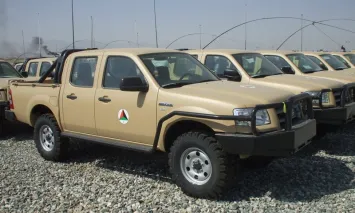 Alasan pengunaan Winch bar Forest meningkatkan keamanan saat tabrakan
Alasan pengunaan Winch bar Forest meningkatkan keamanan saat tabrakanAlasan pengunaan Winch bar Forest meningkatkan keamanan saat tabrakan
- Di Australia – Canada mobil untuk perjalanan outback wajib memiliki Bullbar , disebabkan banyaknya kasus tabrakan dgn Moose/Burung besar/kangguru yg menimbulkan korban jiwa bagi pengemudi. Di Jalanan Indonesia – ternak di jalan juga lumrah & tabrakan dgn binatang juga srg terjadi
- Untuk Eropa - pemasangan Bullbar harus memiliki Ijin. Tapi mereka memiliki Peraturan yg ketat ttg minimal ketinggian palang dari tanah ( rata-rata 65 cm dari tanah ). Di indonesia Truck ukuran menegah maupun berat rata2 memiliki tinggi bumper 70 – 100 cm . Kadang malah tidak memiliki bumper belakang .jika terjadi tabrakan dgn mobil LV. Mobil LV tidak bisa meredam energi tabarkan ( itu megakibatkan kasus mobil masuk kolong truck )> sebab pada mobil LV chasis sebagai cumple zone tinggi rata2 Cuma 50 cm dari tanah . Jika memakai Winch bar > titik tertinggi palang rata2 100 cm dari tanah & akan membagi & menyerap energi tabarakan sehingga penumpang tetap terlindungi
- Desain Crumple zone Winch bar Forest bisa menyerap energi tabrakan hingga 9.5 G compatible dgn sensor Airbag .menjauhkan bahaya dari safety cage ruangan penumpang.
- Winch bar Forest didesain untuk memenuhi segala aspek keselamatan Australia & di test untuk mendapatkan sertifikasi keamananADR69/00
- Meperbaiki approach angle , sehingga bagian depan mobil tak akan mehalangi saat melintasi jalur offroad
- Di Australia – Canada mobil untuk perjalanan outback wajib memiliki Bullbar , disebabkan banyaknya kasus tabrakan dgn Moose/Burung besar/kangguru yg menimbulkan korban jiwa bagi pengemudi. Di Jalanan Indonesia – ternak di jalan juga lumrah & tabrakan dgn binatang juga srg terjadi
- Untuk Eropa - pemasangan Bullbar harus memiliki Ijin. Tapi mereka memiliki Peraturan yg ketat ttg minimal ketinggian palang dari tanah ( rata-rata 65 cm dari tanah ). Di indonesia Truck ukuran menegah maupun berat rata2 memiliki tinggi bumper 70 – 100 cm . Kadang malah tidak memiliki bumper belakang .jika terjadi tabrakan dgn mobil LV. Mobil LV tidak bisa meredam energi tabarkan ( itu megakibatkan kasus mobil masuk kolong truck )> sebab pada mobil LV chasis sebagai cumple zone tinggi rata2 Cuma 50 cm dari tanah . Jika memakai Winch bar > titik tertinggi palang rata2 100 cm dari tanah & akan membagi & menyerap energi tabarakan sehingga penumpang tetap terlindungi
- Desain Crumple zone Winch bar Forest bisa menyerap energi tabrakan hingga 9.5 G compatible dgn sensor Airbag .menjauhkan bahaya dari safety cage ruangan penumpang.
- Winch bar Forest didesain untuk memenuhi segala aspek keselamatan Australia & di test untuk mendapatkan sertifikasi keamananADR69/00
- Meperbaiki approach angle , sehingga bagian depan mobil tak akan mehalangi saat melintasi jalur offroad
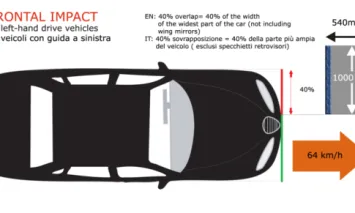 hal menarik dari masukan operator lapangan ttg mobil yg baru disuplay
hal menarik dari masukan operator lapangan ttg mobil yg baru disuplayAda hal menarik dari masukan operator lapangan ttg mobil yg baru disuplay, katanya mobil lama ( no modif – Cuma ganti ban MT ) bebih enak di gunakan – so modifikasi jadinya malah tambah tak enak – goyang – tak lincah ( bumper nongol ) handling jadi aneh.
Artinya modifikasi tak ada benefitnya.
So harus dicari solusi dari deasin awal. Pemasangan bulbar . berat – tak ada crumple zone ( berbahaya & not airbag compatible ) .saat kecelakaan akan merusak chasis & energy tabrakan di terima penumpang tak ada yg terserap ( bisa sangat berbahaya – mematahkan tulang rusuk & kaki )
> solusinya bulbar harus di buat seramping mungkin & berat tidak lebih 50 kg ( kekuatan di peroleh dari tekuan – bahan besi – proses pemotongan /Lasercut – pengelasan –mig . dudukan winch harus diperkuat dgn braket khusus – harus ada Hilift Jack point di bulbar – 3 antena mounting – dudukan aux lamp, braket untuk memperkuat cumplezone di mobil – penambahan crumplezone di bulbar ( harus bisa menyerap energy tabrakan - , ada dudukan untuk 3 keping skid plate . desain bentuk harus aerodinamis untuk deflect abgin & air secara maksimal & tanpa mengurangi volume udara untuk mendinginkan radiator
Jadi pemasangan bullbar ada benefitnya – mobil tetap bisa digunakan pada saat terjadi kecelakaan ringan – dapat meyerap energy tabrakan untuk meminimallan resiko cedera & kerusakan chassis mobil lebih kuat dibanding standart – ada tempat untuk winch /lampu /antenna /skid plate /memperbaiki aprooch agle
Hitungan energi tabrakan
A car with a mass of 2000 kg drives in 60 km/h (16.7 m/s) before it crashes in a massive concrete wall. The front of the car impacts 0.5 m (slow down distance). The impacting force can be calculated as
F = 1/2 (2000 kg) (16.7 m/s)2 / (0.5 m)
= 558 kN ( 558000 joule/meter )
Note that the gravitation force acting on the car is
Fw = m g
= (2000 kg) (9.81 m/s2)
= 19.6 kN
Suspensi – apa yg kita mau cari
Nyaman dikota ( kecepatan 60km < / nayman di high speed 100-150km/ntyaman di jalan rusak 60km
Mofif mesin untuk HP > No, untuk daya tahan oke
Crumple zones are designed to absorb the energy from the impact during a traffic collision by controlled deformation. This energy is much greater than is commonly realized. A 2,000 kg (4,409 lb) car travelling at 60 km/h (37 mph) (16.7 m/s), before crashing into a thick concrete wall, is subject to the same impact force as a front-down drop from a height of 14.2 m (47 ft) crashing on to a solid concrete surface.[7] Increasing that speed by 50% to 90 km/h (56 mph) (25 m/s) compares to a fall from 32 m (105 ft) - an increase of 125%. [7]This is because the stored kinetic energy (E) is given by E = (1/2) mass × speed squared. It increases by the square of the impact velocity.[7][8]
Typically, crumple zones are located in the front part of the vehicle, in order to absorb the impact of a head-on collision, though they may be found on other parts of the vehicle as well. According to a British Motor Insurance Repair Research Centre study of where on the vehicle impact damage occurs: 65% were front impacts, 25% rear impacts, 5% left side, and 5% right side.[9] Some racing cars use aluminium, composite/carbon fibre honeycomb, or energy absorbing foam[10][11] to form an impact attenuator that dissipates crash energy using a much smaller volume and lower weight than road car crumple zones.[12] Impact attenuators have also been introduced on highway maintenance vehicles in some countries.
An early example of the crumple zone concept was used by the Mercedes-Benz engineer Béla Barényi on the mid 1950s Mercedes-Benz "Ponton".[13] This innovation was first patented by Mercedes-Benz in the early 1950s. The patent 854157, granted in 1952, describes the decisive feature of passive safety. Barényi questioned the opinion prevailing till then, that a safe car had to be rigid. He divided the car body into three sections: the rigid non-deforming passenger compartment and the crumple zones in the front and the rear. They are designed to absorb the energy of an impact (kinetic energy) by deformation during collision.
Crumple zones work by managing crash energy, absorbing it within the outer parts of the vehicle, rather than being directly transmitted to the occupants, while also preventing intrusion into or deformation of the passenger cabin. This better protects car occupants against injury. This is achieved by controlled weakening of sacrificial outer parts of the car, while strengthening and increasing the rigidity of the inner part of the body of the car, making the passenger cabin into a 'safety cell', by using more reinforcing beams and higher strength steels. Impact energy that does reach the 'safety cell' is spread over as wide an area as possible to reduce its deformation. Volvo introduced the side crumple zone with the introduction of the SIPS (Side Impact Protection System) in the early 1990s.
When a vehicle and all its contents, including passengers and luggage are travelling at speed, they have inertia / momentum, which means that they will continue forward with that direction and speed (Newton's first law of motion).[18] In the event of a sudden deceleration of a rigid framed vehicle due to impact, unrestrained vehicle contents will continue forwards at their previous speed due to inertia, and impact the vehicle interior, with a force equivalent to many times their normal weight due to gravity. The purpose of crumple zones is to slow down the collision and to absorb energy to reduce the difference in speeds between the vehicle and its occupants.[19]
Seatbelts restrain the passengers so they don't fly through the windshield, and are in the correct position for the airbag and also spread the loading of impact on the body. Seat belts also absorb passenger inertial energy by being designed to stretch during an impact, again to reduce the speed differential between the passenger's body and their vehicle interior.[20] In short: a passenger whose body is decelerated more slowly due to the crumple zone (and other devices) over a longer time survives much more often than a passenger whose body indirectly impacts a hard, undamaged metal car body which has come to a halt nearly instantaneously. It is like the difference between slamming someone into a wall headfirst (fracturing their skull) and shoulder-first (bruising their flesh slightly) is that the arm, being softer, has tens of times longer to slow its speed, yielding a little at a time, than the hard skull, which isn't in contact with the wall until it has to deal with extremely high pressures. The stretching of seatbelts while restraining occupants during an impact, means that it is necessary to replace them if a vehicle is repaired and put back on the road after a collision. They should also be replaced if their condition has deteriorated e.g. through fraying or mechanical or belt mounting faults. In New Zealand it is officially mandatory to replace worn inertia reel type seatbelts only with 'webbing grabber' type belts that have less play and are more effective on older cars.[21]Newer cars have electronically fired pre-tension seatbelts that are timed to work with the airbag firing. Buying used seatbelts is not a good idea even in countries where it is legal to do so, because they may have already been stretched in an impact event and may not protect their new users as they should.
The final impact after a passenger's body hits the car interior, airbag or seat belts is that of the internal organs hitting the ribcage or skull due to their inertia. The force of this impact is the way by which many car crashes cause disabling or life-threatening injury. Other ways are skeletal damage and blood loss, because of torn blood vessels, or damage caused by sharp fractured bone to organs and/or blood vessels. The sequence of energy-dissipating and speed-reducing technologies—crumple zone — seat belt — airbags — padded interior—are designed to work together as a system to reduce the force of the impact on the outside of the passenger(s)'s body and the final impact of organs inside the body. In a collision, slowing down the deceleration of the human body by even a few tenths of a second drastically reduces the force involved. Force is a simple equation: Force = mass X acceleration. Cutting the deceleration in half also cuts the force in half. Therefore, changing the deceleration time from .2 seconds to .8 seconds will result in a 75 percent reduction in total force.[22]
A US Market Ford Escort that has been involved in an offset head-on collision with a Sport Utility Vehicle - showing the raised point of impact - missing the car crumple zone.
A misconception about crumple zones sometimes voiced[citation needed] is that they reduce safety for the occupants of the vehicle by allowing the body to collapse, therefore risking crushing the occupants. In fact, crumple zones are typically located in front of and behind the main body of the car (which forms a rigid 'safety cell'), compacting within the space of the engine compartment or boot/trunk. Modern vehicles using what are commonly termed 'crumple zones' provide far superior protection for their occupants in severe tests against other vehicles with crumple zones and solid static objects than older models or SUVs that use a separate chassis frame and have no crumple zones.
They do tend to come off worse when involved in accidents with SUVs without crumple zones because most of the energy of the impact is absorbed by the vehicle with the crumple zone — however, even for the occupants of the 'worse off' car, this will still often be an improvement — as the result of two vehicles without crumple zones colliding will usually be more hazardous to both vehicle's occupants than a collision that is at least partly buffered.[citation needed]
Another problem is 'impact incompatibility' where the 'hard points' of the ends of chassis rails of SUVs are higher than the 'hard points' of cars, causing the SUV to 'override' the engine compartment of the car.[17] In order to tackle this problem, recent Volvo SUV/off-roaders incorporate structures below the front bumper designed to engage lower-height car crumple zones.
Artinya modifikasi tak ada benefitnya.
So harus dicari solusi dari deasin awal. Pemasangan bulbar . berat – tak ada crumple zone ( berbahaya & not airbag compatible ) .saat kecelakaan akan merusak chasis & energy tabrakan di terima penumpang tak ada yg terserap ( bisa sangat berbahaya – mematahkan tulang rusuk & kaki )
> solusinya bulbar harus di buat seramping mungkin & berat tidak lebih 50 kg ( kekuatan di peroleh dari tekuan – bahan besi – proses pemotongan /Lasercut – pengelasan –mig . dudukan winch harus diperkuat dgn braket khusus – harus ada Hilift Jack point di bulbar – 3 antena mounting – dudukan aux lamp, braket untuk memperkuat cumplezone di mobil – penambahan crumplezone di bulbar ( harus bisa menyerap energy tabrakan - , ada dudukan untuk 3 keping skid plate . desain bentuk harus aerodinamis untuk deflect abgin & air secara maksimal & tanpa mengurangi volume udara untuk mendinginkan radiator
Jadi pemasangan bullbar ada benefitnya – mobil tetap bisa digunakan pada saat terjadi kecelakaan ringan – dapat meyerap energy tabrakan untuk meminimallan resiko cedera & kerusakan chassis mobil lebih kuat dibanding standart – ada tempat untuk winch /lampu /antenna /skid plate /memperbaiki aprooch agle
Hitungan energi tabrakan
A car with a mass of 2000 kg drives in 60 km/h (16.7 m/s) before it crashes in a massive concrete wall. The front of the car impacts 0.5 m (slow down distance). The impacting force can be calculated as
F = 1/2 (2000 kg) (16.7 m/s)2 / (0.5 m)
= 558 kN ( 558000 joule/meter )
Note that the gravitation force acting on the car is
Fw = m g
= (2000 kg) (9.81 m/s2)
= 19.6 kN
Suspensi – apa yg kita mau cari
Nyaman dikota ( kecepatan 60km < / nayman di high speed 100-150km/ntyaman di jalan rusak 60km
Mofif mesin untuk HP > No, untuk daya tahan oke
Crumple zones are designed to absorb the energy from the impact during a traffic collision by controlled deformation. This energy is much greater than is commonly realized. A 2,000 kg (4,409 lb) car travelling at 60 km/h (37 mph) (16.7 m/s), before crashing into a thick concrete wall, is subject to the same impact force as a front-down drop from a height of 14.2 m (47 ft) crashing on to a solid concrete surface.[7] Increasing that speed by 50% to 90 km/h (56 mph) (25 m/s) compares to a fall from 32 m (105 ft) - an increase of 125%. [7]This is because the stored kinetic energy (E) is given by E = (1/2) mass × speed squared. It increases by the square of the impact velocity.[7][8]
Typically, crumple zones are located in the front part of the vehicle, in order to absorb the impact of a head-on collision, though they may be found on other parts of the vehicle as well. According to a British Motor Insurance Repair Research Centre study of where on the vehicle impact damage occurs: 65% were front impacts, 25% rear impacts, 5% left side, and 5% right side.[9] Some racing cars use aluminium, composite/carbon fibre honeycomb, or energy absorbing foam[10][11] to form an impact attenuator that dissipates crash energy using a much smaller volume and lower weight than road car crumple zones.[12] Impact attenuators have also been introduced on highway maintenance vehicles in some countries.
An early example of the crumple zone concept was used by the Mercedes-Benz engineer Béla Barényi on the mid 1950s Mercedes-Benz "Ponton".[13] This innovation was first patented by Mercedes-Benz in the early 1950s. The patent 854157, granted in 1952, describes the decisive feature of passive safety. Barényi questioned the opinion prevailing till then, that a safe car had to be rigid. He divided the car body into three sections: the rigid non-deforming passenger compartment and the crumple zones in the front and the rear. They are designed to absorb the energy of an impact (kinetic energy) by deformation during collision.
Crumple zones work by managing crash energy, absorbing it within the outer parts of the vehicle, rather than being directly transmitted to the occupants, while also preventing intrusion into or deformation of the passenger cabin. This better protects car occupants against injury. This is achieved by controlled weakening of sacrificial outer parts of the car, while strengthening and increasing the rigidity of the inner part of the body of the car, making the passenger cabin into a 'safety cell', by using more reinforcing beams and higher strength steels. Impact energy that does reach the 'safety cell' is spread over as wide an area as possible to reduce its deformation. Volvo introduced the side crumple zone with the introduction of the SIPS (Side Impact Protection System) in the early 1990s.
When a vehicle and all its contents, including passengers and luggage are travelling at speed, they have inertia / momentum, which means that they will continue forward with that direction and speed (Newton's first law of motion).[18] In the event of a sudden deceleration of a rigid framed vehicle due to impact, unrestrained vehicle contents will continue forwards at their previous speed due to inertia, and impact the vehicle interior, with a force equivalent to many times their normal weight due to gravity. The purpose of crumple zones is to slow down the collision and to absorb energy to reduce the difference in speeds between the vehicle and its occupants.[19]
Seatbelts restrain the passengers so they don't fly through the windshield, and are in the correct position for the airbag and also spread the loading of impact on the body. Seat belts also absorb passenger inertial energy by being designed to stretch during an impact, again to reduce the speed differential between the passenger's body and their vehicle interior.[20] In short: a passenger whose body is decelerated more slowly due to the crumple zone (and other devices) over a longer time survives much more often than a passenger whose body indirectly impacts a hard, undamaged metal car body which has come to a halt nearly instantaneously. It is like the difference between slamming someone into a wall headfirst (fracturing their skull) and shoulder-first (bruising their flesh slightly) is that the arm, being softer, has tens of times longer to slow its speed, yielding a little at a time, than the hard skull, which isn't in contact with the wall until it has to deal with extremely high pressures. The stretching of seatbelts while restraining occupants during an impact, means that it is necessary to replace them if a vehicle is repaired and put back on the road after a collision. They should also be replaced if their condition has deteriorated e.g. through fraying or mechanical or belt mounting faults. In New Zealand it is officially mandatory to replace worn inertia reel type seatbelts only with 'webbing grabber' type belts that have less play and are more effective on older cars.[21]Newer cars have electronically fired pre-tension seatbelts that are timed to work with the airbag firing. Buying used seatbelts is not a good idea even in countries where it is legal to do so, because they may have already been stretched in an impact event and may not protect their new users as they should.
The final impact after a passenger's body hits the car interior, airbag or seat belts is that of the internal organs hitting the ribcage or skull due to their inertia. The force of this impact is the way by which many car crashes cause disabling or life-threatening injury. Other ways are skeletal damage and blood loss, because of torn blood vessels, or damage caused by sharp fractured bone to organs and/or blood vessels. The sequence of energy-dissipating and speed-reducing technologies—crumple zone — seat belt — airbags — padded interior—are designed to work together as a system to reduce the force of the impact on the outside of the passenger(s)'s body and the final impact of organs inside the body. In a collision, slowing down the deceleration of the human body by even a few tenths of a second drastically reduces the force involved. Force is a simple equation: Force = mass X acceleration. Cutting the deceleration in half also cuts the force in half. Therefore, changing the deceleration time from .2 seconds to .8 seconds will result in a 75 percent reduction in total force.[22]
A US Market Ford Escort that has been involved in an offset head-on collision with a Sport Utility Vehicle - showing the raised point of impact - missing the car crumple zone.
A misconception about crumple zones sometimes voiced[citation needed] is that they reduce safety for the occupants of the vehicle by allowing the body to collapse, therefore risking crushing the occupants. In fact, crumple zones are typically located in front of and behind the main body of the car (which forms a rigid 'safety cell'), compacting within the space of the engine compartment or boot/trunk. Modern vehicles using what are commonly termed 'crumple zones' provide far superior protection for their occupants in severe tests against other vehicles with crumple zones and solid static objects than older models or SUVs that use a separate chassis frame and have no crumple zones.
They do tend to come off worse when involved in accidents with SUVs without crumple zones because most of the energy of the impact is absorbed by the vehicle with the crumple zone — however, even for the occupants of the 'worse off' car, this will still often be an improvement — as the result of two vehicles without crumple zones colliding will usually be more hazardous to both vehicle's occupants than a collision that is at least partly buffered.[citation needed]
Another problem is 'impact incompatibility' where the 'hard points' of the ends of chassis rails of SUVs are higher than the 'hard points' of cars, causing the SUV to 'override' the engine compartment of the car.[17] In order to tackle this problem, recent Volvo SUV/off-roaders incorporate structures below the front bumper designed to engage lower-height car crumple zones.
HOT DEALS
Follow Instagram @tas4x4
Video
CI-RE(VO) BO(R)N 2019
Toyota Landcruiser BJ40 1985 Hardtop diesel Super langka
Fortuner VRZ Transformer siap Offroad





